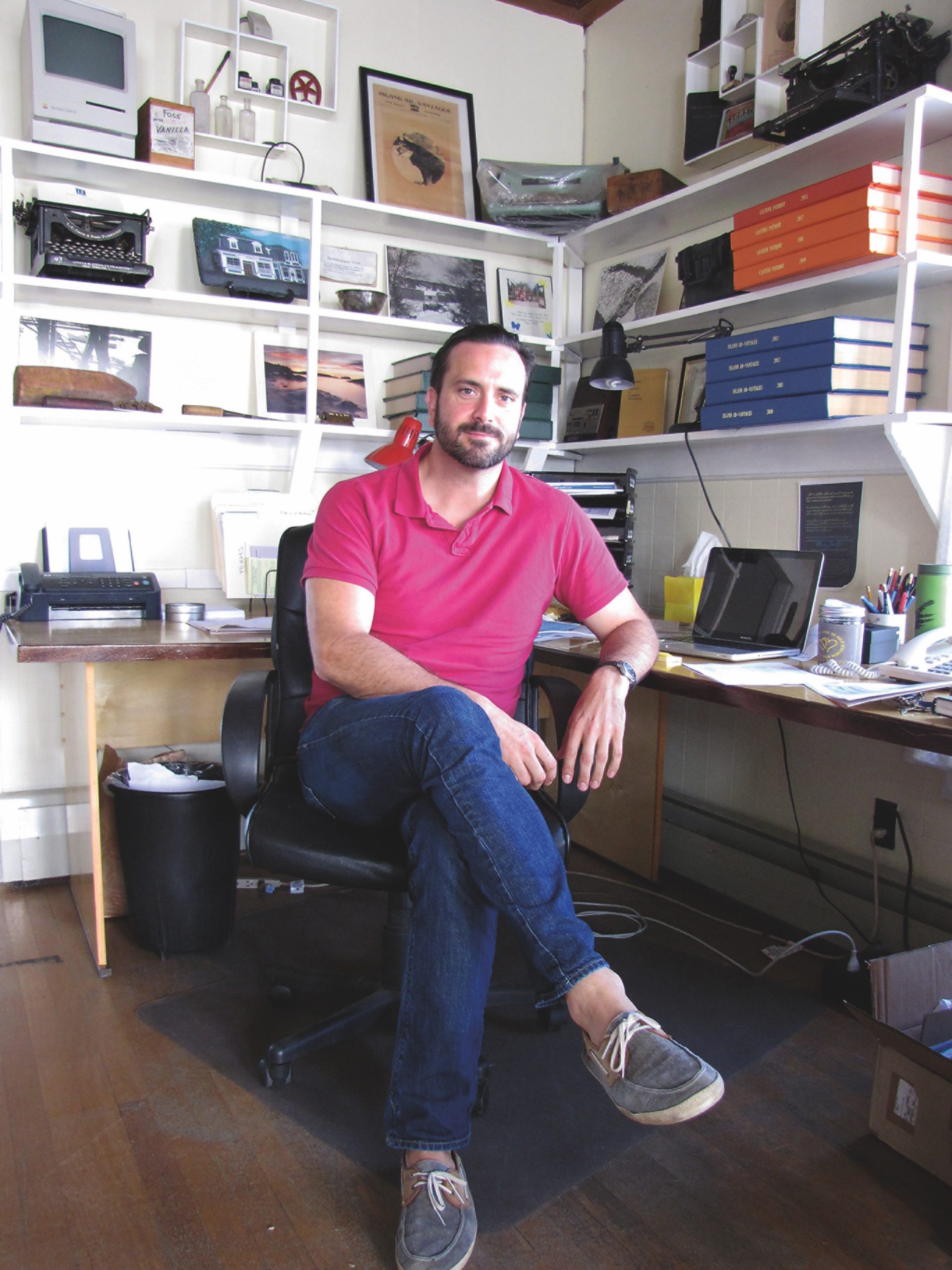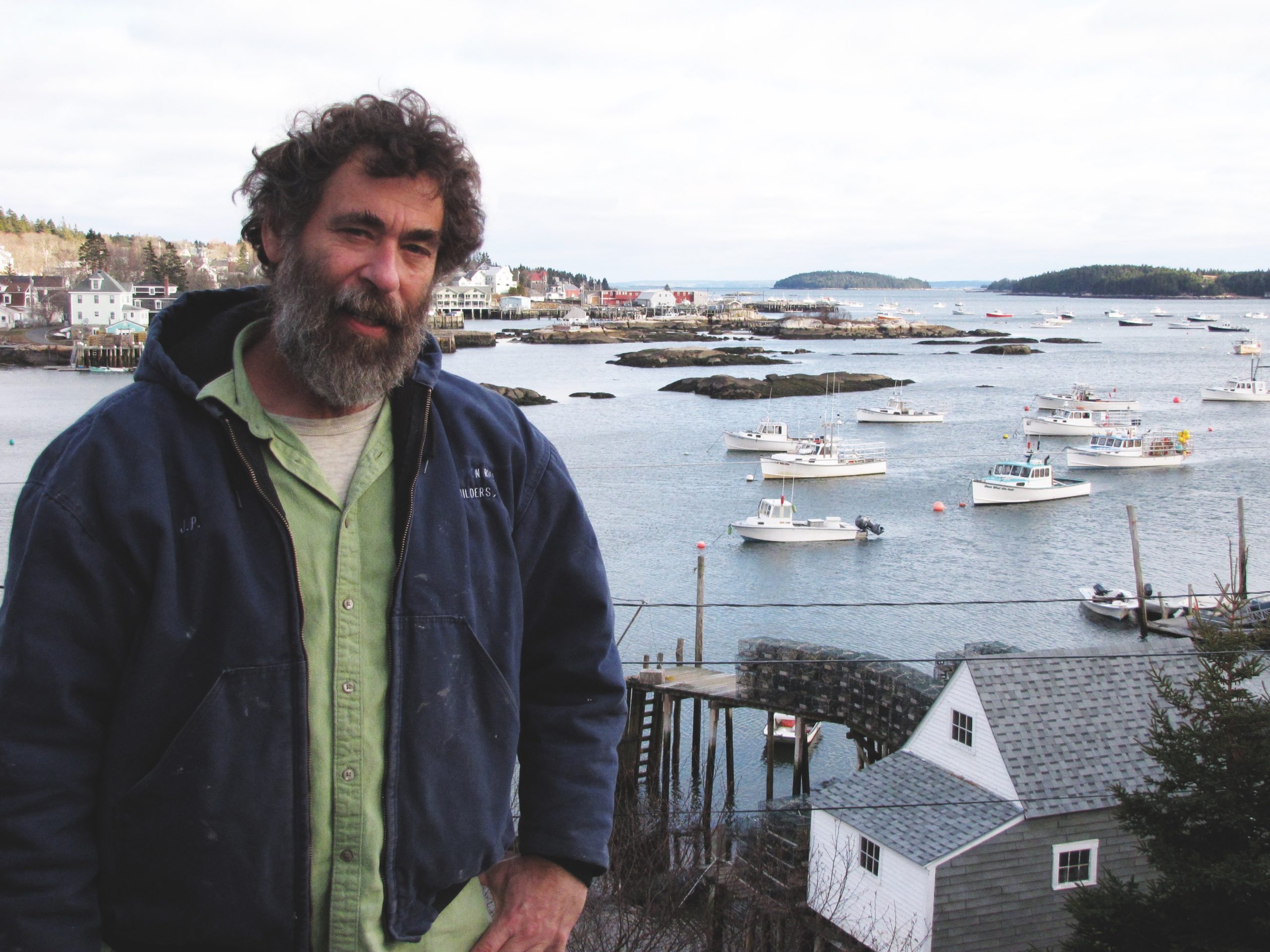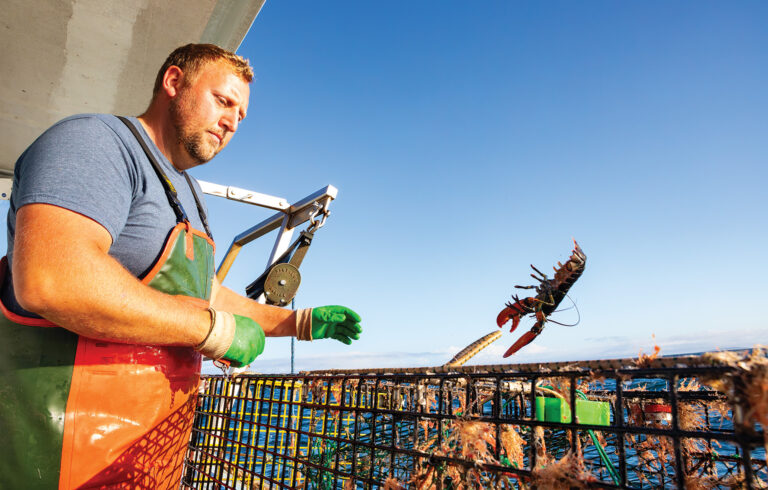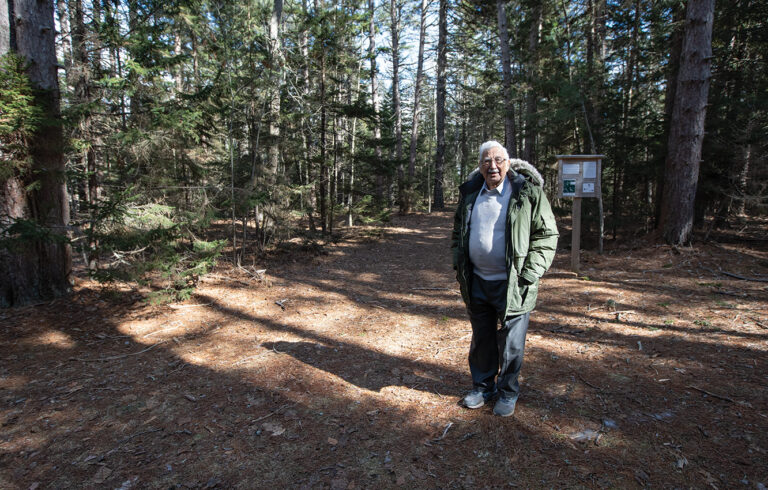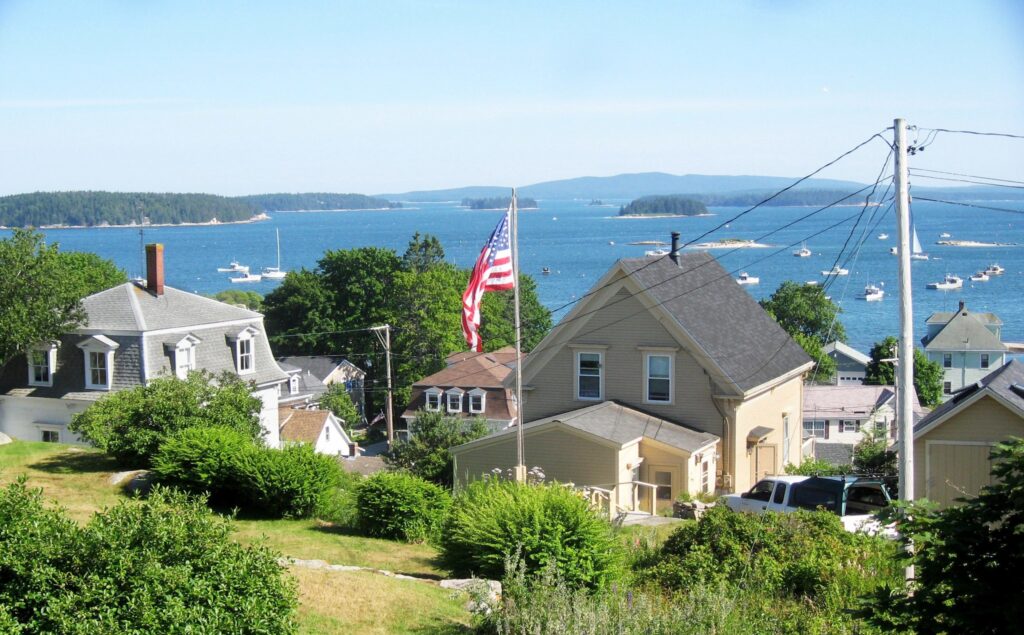
Stonington: A Town on the Edge
Contradictions abound, but resiliency abides.
STORY AND PHOTOS BY TOM GROENING
If anyone has a finger on the pulse of a community, it’s the guy who runs the town’s weekly newspaper. And what does Ben Barrows, general manager of the Island Ad-Vantages, think about his hometown?
“On any given day, I might feel discouraged or hopeful,” he admits. “Everything we need to be successful is here—human creativity and resourcefulness.”
But others worry that such success could mean Stonington loses its genuine quality, a feature valued by newcomers and natives alike. That could mean someone like Kathleen Billings-Pezaris, the native-born town manager, might not be able to afford a home in Stonington.
Still others, like longtime fishermen Frank Gotwals and Jeff Dworsky, both of whom arrived in the early 1970s, say forces already have wrought significant change in Stonington. Yet Robin Alden, who heads up a nonprofit working to support local fishing, says even bigger changes may be on the horizon if lobster populations suddenly crash.
The forces and features that define Stonington seem contradictory. But in conversation with some who have witnessed the town’s last chapter being written, and those who are writing its next, those contradictions tell the story.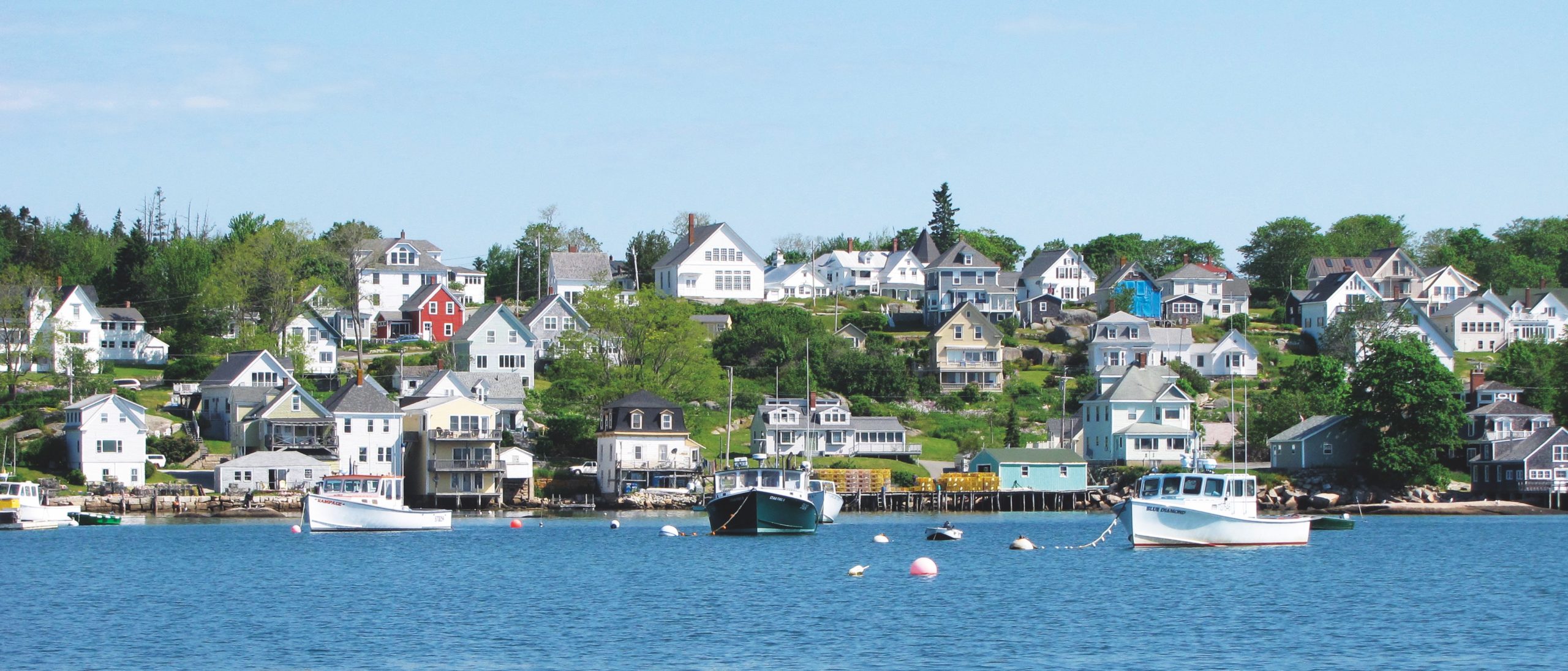
It’s on an island, at the southern tip of Deer Isle, yet that island is connected to the mainland by a bridge. The bridge allows lobster—20 million pounds or more each year, perennially making it the top lobster-landing port in the state—to be carried by truck to market.
But Stonington is isolated. For most of Maine’s residents and tourists, it’s easier to get to Vinalhaven. Locals are quick to point out that it’s an hour’s drive from US Route 1, and, of course, another hour and more from I-95.
There are more contradictions.
Stonington’s downtown has the gritty quality you would expect in a fishing town. A notice posted in the town office hints at the rough-around-the-edges life, scolding fishermen for “unnecessary tire noise, driving to endanger, breaking of bottles, vulgar language, etc.” at the pier.
Such bad behavior probably is confined to the hours after dark, when day-trippers are long gone and other visitors have retired to their rooms in the motel or in the inns. Just in case those visitors missed the in-plain-sight evidence, signs on trash cans remind them that Stonington is a working waterfront community.
The tourists do come, though, because the town is chock-full of attractive homes and commercial buildings, tucked into a hillside that gives long views down Penobscot Bay, and of scores of working lobster boats. It’s an alluring place that has brought artists summer after summer, and the number of galleries in the tiny downtown suggests they are able to sell their work.
These contradictions have been at work for decades and are part of its strength, say Stonington’s key players. But they worry about its future. The largest contrary forces, it seems, are the inevitable changes that will roll down the peninsula and onto Deer Isle, and the deep desire of many for Stonington to remain an authentic fishing town.
“Everything we need to be successful is here: human creativity and resourcefulness.”
—Ben Barrows
The Island Ad-Vantages newspaper office where Ben Barrows meets with me has a spare, old-fashioned look. The building could serve as a set for an early-20th-century period film. Some of the look is by design; Barrows, 33, general manager of the company that runs the Stonington weekly, as well as the Castine Patriot and the (Blue Hill) Weekly Packet, has a manual typewriter and an early Apple computer on shelves over his desk.
His father, Nat Barrows, has owned the papers for the past 30-plus years. Ben has returned to the town in which he grew up and attended high school to help out his father, but not before seeing a bit of the world. Actually, he’s seen a lot of the world—Antarctica, Iraq, Jordan, Afghanistan, various African countries—all in humanitarian service.
While pride in Stonington is evident, he is frank about its shortcomings, as seen through the eyes of a young man: “The lack of access to ethnic food, other cultures and their ideas.” But returning after a dozen years traveling the world, Barrows embraces “the opportunity to have depth rather than breadth.”
He serves as a town selectman, a post he takes seriously.
Stonington has changed in the years he’s been away, with “more people, more development,” but “the essential aspects of its identity are unchanged,” he said.
Change is inevitable, though.
“Eventually, those outside forces will make their way into this community.”
We talk about fishing and tourism, trophy homes and trailers, and he is thoughtful, analytical, but very much leaning into the work of keeping the town vital.
The town has a sense of place, “and a fierce pride in what we do. The fact that we’re off the beaten path—the end of the road, literally—makes it a special place. There’s a bounty of blessings from the natural world,” he says, meaning everything from lobster to the cool sea breezes of summer.
But when that inevitable change does come, “It’s not going to be a smooth trajectory.”
History provides some hope, though.
“We started as a granite town, and then we were a shipbuilding town, and then a fishing town,” and it wasn’t lobster, but cod that filled the holds and paid the bills. “All of those things have collapsed, yet the town has carried on. It’s still a great place to live and work. We’re tough.”
In the context of our hour-plus conversation, that’s not a trite, ready-made chamber of commerce quote. Barrows speaks authoritatively of the struggle to adapt, to remain vital and authentic.
“Questions of identity are never really far behind balancing the working waterfront and cruisers and tourism,” he says, then pauses. “Sometimes I feel we have to sort out the identity thing first.”
Unloading the day’s catch at one of Stonington’s lobster co-ops.
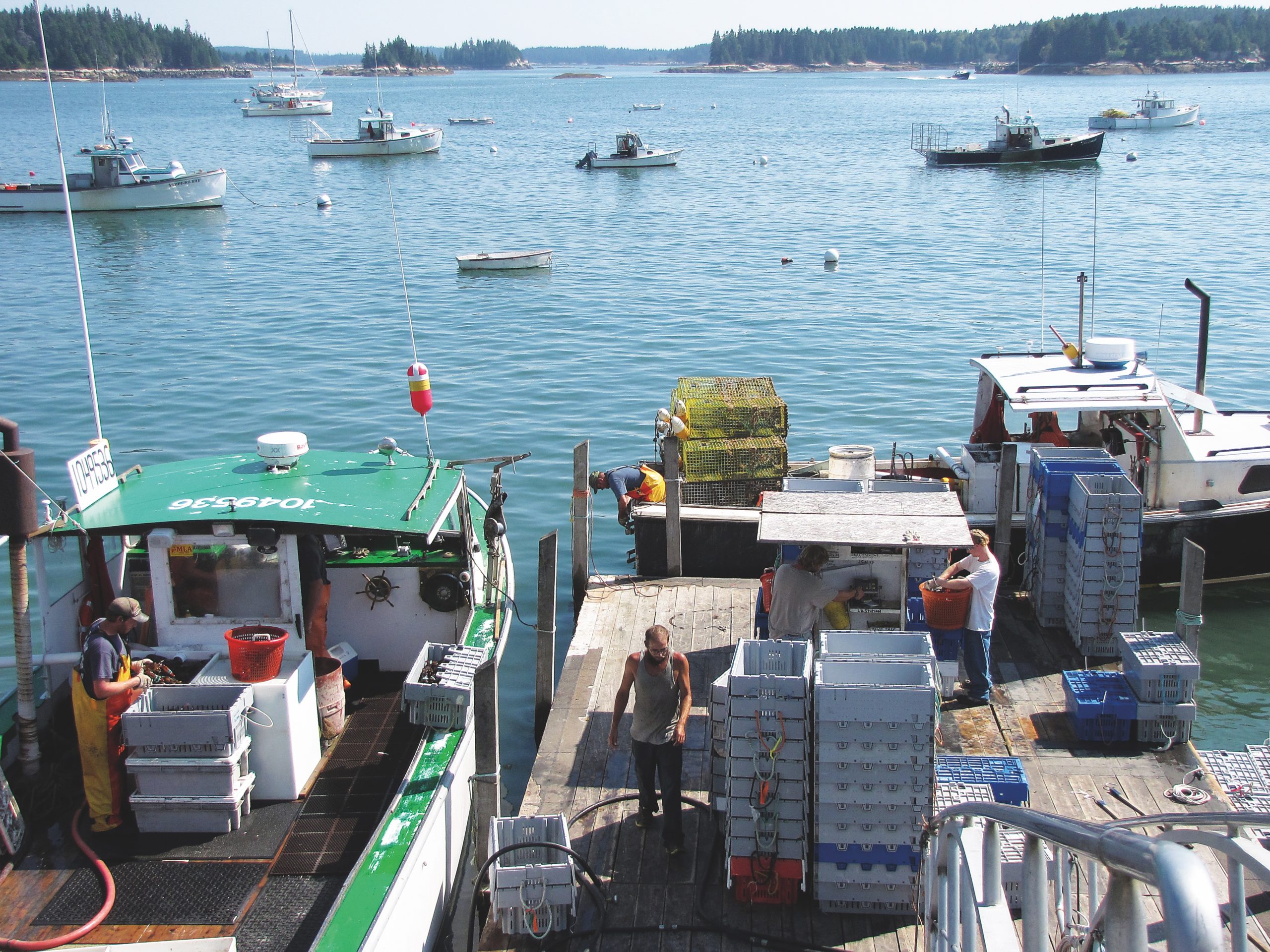
Frank Gotwals moved to Stonington in 1973, taking a leave of absence from college. His family had ties to the island, and he summered here as a child. His first work came in raking sea moss, then, in 1976, he began lobstering.
“That led to one thing after another, and I never left.”
Landing at one of the three buying stations on a perfect late September afternoon, Gotwals’s boat, sea song, stands out. It’s remarkably clean, a two-year-old wooden boat. He and his sternman, a young woman, efficiently sort their catch, then he grabs a cup of coffee from the store and we talk, sitting in the shade of the statue of a granite cutter.
Blond and handsome, he looks younger than his 59 years, despite being on the water all day. That look suits the other life he’s had, playing guitar and singing his own songs. He’s put out CDs, including Beach Glass and Unfamiliar Sea (both available on iTunes), and the music is solid singer-songwriter fare, flavored by references to his fishing life, boosted by his exceptional finger-picking guitar work.
Though he no longer tours through New England, he still plays out, often performing with others.
In the early 1970s, he would have stood out as a summer person doing something unusual, trying to make Stonington his home. Back then, “most of the downtown houses were local families,” Gotwals says.
Until the early 1980s, there were two grocery stores, a hardware store, a pharmacy, and other businesses that made the town more self-sufficient. “There was one real estate agent when I was a kid,” he remembers, “and then all of a sudden, there were five or six,” he says, letting that fact explain larger forces at work.
He’s not bitter, not nostalgic exactly, but more philosophical about the changes. Or maybe just tired from a long week of fishing.
Everyone in a fishing town like Stonington has thought about the unthinkable—a collapse of lobstering.
“It’s always been unpredictable,” Gotwals says. “But there’s no other options, as far as fishing. If we don’t have lobstering, we won’t be a fishing town, and we will have to reinvent ourselves. I also know I made a living at it, in some really lean times,” he adds, suggesting that being prudent about saving and investing is key.
The fishing pier saw state and federal investment in the late 1980s and early 1990s, Gotwals recalled, after the United States asserted its rights over near-shore fishing, kicking out fish-factory ships from Russia and other nations. “At the time, there were a fair amount of gill-net boats out of Stonington,” he said. But that fishery did not rebound as expected.
The summer renters and second-home buyers have given the village a prosperous sheen, but that doesn’t tell the whole story.
“There’s a lot of people here who struggle,” Gotwals says. Land costs have gone up. The young woman who works on his boat lives on the other side of the bridge, as do many in her economic situation.
Forty years after leaving college for Stonington, he’s got no regrets.
“This always seemed like home to me. I like living here—I like what it has to offer. I’ve been fortunate to make an interesting life here. I choose to live here,” he says, and with a grin, adds, “I’m still on my leave of absence from college.”
Jeff Dworsky
Like Gotwals, Jeff Dworsky also arrived in Stonington in 1973. A photographer by trade (his excellent documentary work was featured in Island Journal in the mid-1990s), Dworsky began lobstering in those early years.
At that time, 95 percent of the homes were owned by fishermen.
“There were all these beautiful homes and shorefront,” he says, pointing out a favorite bought by a seasonal resident a few years ago.
Dworsky, 59, came to town from Cambridge, Massachusetts, but he expresses a native’s curmudgeonly crankiness about changes—a description he chuckles at when I make it—that have unfurled over the decades.
“I was the beginning of the wave,” he admits, as he and others of his generation left cities for rural Maine. At just 17, he and three others split the rent on a building that previously “had been a whorehouse,” he says.
Today, the seasonal and second-home residents complain about drunk fishermen and locals driving too fast, he claims, trying to neuter what he sees as “the rugged independence” of the place. “But it was also gentle and kind and giving,” and neighbors were nice to each other. Today, “They’re not getting along. All those fences went up,” he says.
“When I first came here, this was too far from the major cities to be attractive for seasonal homes,” he says.
That’s changed.
One seasonal resident whom Dworsky counts as a friend is Jill Hoy. Hoy, 60, paints lovely realistic landscapes and runs a gallery in town. She’s been summering here since she was nine. Artists, like fishermen, struggle to make it in Stonington, she says. And the arts have been good for the economy, she believes.
“People follow artists, oftentimes, and they often follow beauty,” Hoy says. “I see a lot of Swedish and German travelers, and I ask them how they came to visit.” They tell her they looked at a map, saw the town at the end of the peninsula, and were intrigued enough to visit.
“We’re lucky to be as far down Route 15 as we are,” she says. “It preserves it, to some extent. It immediately rules out a lot of people,” who don’t make the effort to visit.
~
Few have had both the longevity and insider status to understand Stonington as well as Kathleen Billings-Pezaris, the town manager. Growing up in the 1960s and ’70s, and graduating from the high school in 1981, she’s as native as they come.
There’s no hesitation as she describes the town of her childhood: “Poor.”
But waves of building came in the subsequent decades. Is a tipping point coming?
“Yeah, I worry about that,” she says. Many more people are “buying across the Reach,” on the mainland side of the bridge. “Housing is going to be a problem. When is it that I can’t afford to live on the island?”
Half of the water company’s customers shut off their service in the winter, an indication of how seasonal the downtown has become. But the newcomers and the arts have injected money and energy.
“I think it’s a positive—the more that we can diversify, as a community and an economy, the better off we are,” says Billings-Pezaris, although she admits she sometimes hears locals say there are too many galleries in town.
Another source of energy and investment came from wealthy financier Donald Sussman, who once owned a nearby summer residence, she says. He bought and renovated large waterfront and Main Street buildings, one of which became the improved grocery store, and the other, home to Penobscot East Resource Center, a nonprofit that works to support fishing.
“We were lucky someone was willing to invest in some of these properties,” Billings-Pezaris says. The improvements spurred others to fix up their homes and businesses, she believes.
As manager, her goals are to see a vibrant, fishing harbor, stronger shoulder seasons for tourism, and for the town’s authenticity to remain intact.
~
Fishing dominates Stonington’s economy. Or, maybe better put, Stonington dominates fishing. It’s Maine’s top lobster-landing port, year after year. In 2013, more than 20 million pounds were landed, at a value of $43 million. There are 300 to 400 independently owned fishing boats in the harbor. Nationally, the port ranks 21st for value of catch and 43rd by volume.
Fishing is what brought Robin Alden to Stonington, but not to haul traps or set nets. Alden, who, like Dworsky, hails from Cambridge, Massachusetts, took a year off from Yale University in 1971 and stayed on the island, later finishing her degree at the University of Maine. In 1973 she founded Commercial Fisheries News, which she operated for 20 years. Other than the three years she served as marine resources commissioner under Governor Angus King, Alden never left town.
Now the director of Penobscot East Resource Center, the nonprofit that works to ensure that locals can “fish forever,” as its motto puts it, she has seen the changes and challenges Stonington has faced, but remains optimistic about the future.
“The downtown has changed dramatically,” Alden says. When she arrived, it was a bustling and self-contained year-round community. Now, in winter, “It’s pretty close to a ghost town,” she says.
“Some of the changes in the culture of the town, the activities of the town, have come from the retirees,” Alden notes. Many retirees have been active in the community, and Alden sees that as a positive. “I like the mix of people who live here.”
Asked about a possible collapse of the lobster industry, she redirects the question.
“I think we should look at the strengths.” Each of the harbor’s fishing boats represents an independently owned business, she says, and each creates ripples in the local economy.
Alden knows the record lobster catches of recent years are not likely to last, given that they exceed—by about fivefold—the long-term averages.
“We’re in some kind of ecological bubble,” she says. “What we don’t know is how gracefully the industry will contract if the resource contracts.”
But there is much to be optimistic about, Alden believes.
“We ship out an incredible amount of granite,” she notes, a resurgence in an industry that was dominant in the 19th century. Billings Shipyard is thriving, serving the many working and pleasure boats that pass through the area.
~
Linda Nelson is recommended to me again and again as a must-interview source. Early in 2015, Nelson was appointed assistant director of the state’s arts commission, and so will be working in Augusta. It’s a job she’s earned, most Stonington residents would agree.
Like many Maine coastal towns (Belfast, Camden, Rockport, Boothbay), Stonington has an opera house, the result of a much earlier generation’s ideas of bringing culture to the rugged coast. But here, it’s more than a pretty old building; it’s been the nursery for a vibrant arts scene.
That’s because Nelson and three other women arrived in town in 1999 and set out to revive the local arts, a tradition that extends back to the 1890s, when the opera house was built. It burned in 1910, but a new one was built in 1912.
A nonprofit—Opera House Arts—was established in 1999 to both restore the building, which had sat vacant for eight years, and to provide a variety of arts programming for the community.
Nelson recalls meeting with town selectmen who “wholeheartedly supported” the plan. Did the community embrace or resist the vision?
“A combination of those things,” she remembers, in part because four women—“four gay women,” she wryly notes—were the driving force. The town seemed to take a wait-and-see approach, she says, but when the women proved they could work hard to achieve their goals, people got on board.
Nelson hails from Stonington, Connecticut, and coming to Maine’s Stonington was by design. A Bowdoin grad, she knew Maine, and Stonington.
“It’s a great place. I think it’s one of the last genuine places,” she says. “We wanted to be part of a real working community. Stonington is one of a very few communities with an extractive industry”—lobstering—“which is thriving. We wanted to create culture that has real meaning” for people of such a community, she says.
The opera house features films, staged readings, plays, live music, and other performances, and the organization offers arts programs in the local schools. It generates at least $1 million in economic activity in the area, Nelson believes.
“We’re always working to create diversity. We have to promote Stonington as a destination,” she says, with the arts offerings part of that effort.
Will Stonington retain its genuineness, the quality that drew her?
“I think it will, because people want that.”
~
Fishing brought Brent Oliver, 54, back to Stonington and his family’s roots. His father, a native, had followed fish to other ports, but returned here with his family in 1969.
By 1983, the younger Oliver was working in gill netting, but federal regulations seemed to thwart his efforts. From 1996 on, he has been lobstering full-time.
As important as fishing has been to him, Oliver sees a bigger-picture future for the town.
“It will stay a fishing town,” he says, “but we need more than just fishermen on this island. If we could have six months of July and August , it would thrive. I welcome the tourists, as long as they don’t want to change the world.”
In the 1990s, Oliver saw retirees move to the area and run for school board and selectmen seats, a trend he believes was not good for the town. Yet change must come, he says, and he welcomes technological and commercial advances.
“The world is changing, and I don’t want to see Deer Isle and Stonington left behind.”

